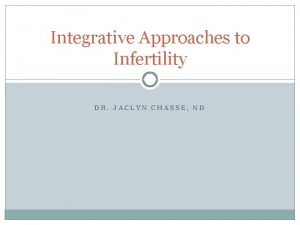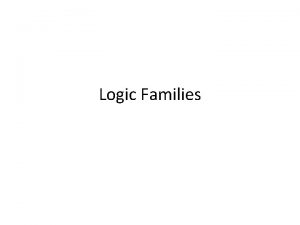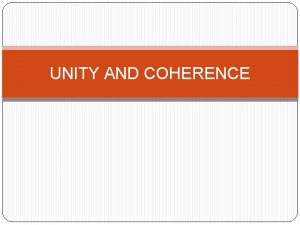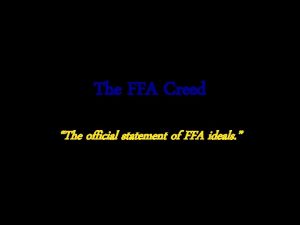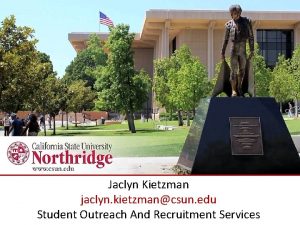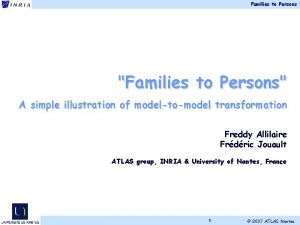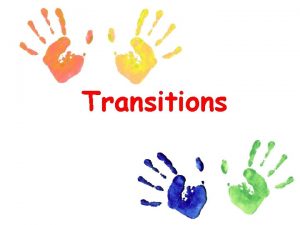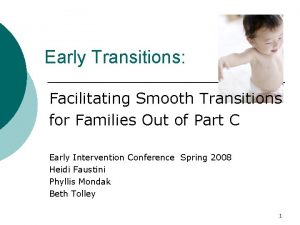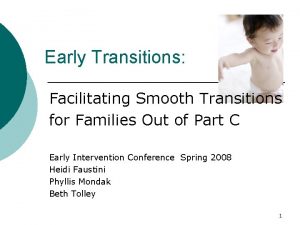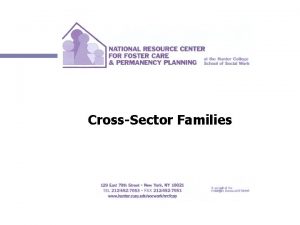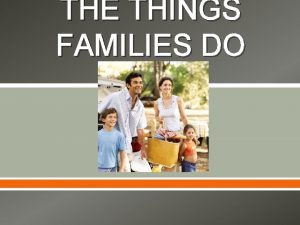Transitions adopted persons and their families Presenter Jaclyn

















- Slides: 17

Transitions: adopted persons and their families Presenter: Jaclyn Skalnik, MSW, CAPSW Adoption Wellness LLC Coalition for Children, Youth & Families August 7, 2014

Transition - definition a movement, passage, or change from one state, stage, concept or subject to another www. adoptionwellness. com

The Three Goals: To help parents understand why transitions can be critical to an adopted child To identify when your child is stressed To provide techniques to minimize or manage the stress/anxiety related to transitions www. adoptionwellness. com

Core Issues of Adoption for the Adopted Person 1. 2. 3. 4. 5. 6. 7. Loss Rejection Guilt/Shame Grief Identity Intimacy & Relationships Control/Gains www. adoptionwellness. com

What Causes Stress & Anxiety for Adopted Persons? The unknown / new situations Not having basic needs met Fears Trauma Loss Expectations www. adoptionwellness. com

Examples of Transitions: Life events: birth, adoption, death, marriage or divorce Move to a new home School Friends Adults/authority www. adoptionwellness. com

Reactions to Transitions All children have their own reaction to transitions. Adopted persons may react to transitions differently based on their history, personality, age, experiences, trauma, loss and how they are parented. Responses: external reaction internal reaction www. adoptionwellness. com

School Starting a new school Returning to school after a break Triggers of core adoption issues: New teacher New friends Loss Separation Identity Authority Expectations & Rejection www. adoptionwellness. com

Family Events Birth, foster or adoption of a new child =Threatens the child and is seen as competition Marriage, separation or divorce =Challenges permanency, love and perpetuates rejection Death of a pet or loved one =Abandonment, grief or loss www. adoptionwellness. com

Tools for a Parent’s Backpack School: Be Planful and Intentional -Arrange a visit to a new school prior to the school year starting -Take photos and create a story-board -Involve the child in the preparations of school (supplies, clothing, etc. ) -Connect with other families and their children -Establish a “plan” with the school www. adoptionwellness. com

Tools (cont. ) New Home -Involve the child in the packing and moving -Give the child some control over their new space -Have a closing ceremony at the old house and an opening ceremony at the new house -Retain a tangible symbol to transition between homes www. adoptionwellness. com

Tools (cont. ) New Family/Caregiver -Create and review a memory or life book that includes photos, notes or special memories -Transitional item: photo, blanket, favorite item, etc. -Keep dialogue open about feelings -Support the child with reinforcing statements regarding their permanency and role www. adoptionwellness. com

Tools (cont. ) New Relationships -Encourage safe space -Support boundaries -Supervise new meetings -Talk with parents -Keep communication open -Be cognizant of social anxiety, fear of rejection and people-pleasing attempts www. adoptionwellness. com

Tools (cont. ) New Family Member -Prepare for the new family member with casual discussion -Include children in the home in preparing the new child’s space -Encourage deliberate, uninterrupted special time with other children in the home -Validate all children’s feelings www. adoptionwellness. com

Tools (cont. ) Death of a Pet or Loved One -Talk about the emotions being experienced -Review photos and memories of the loved one -Validate the loss before reinforcing the gains -Self-disclose -Attend or create a ceremony of closure www. adoptionwellness. com

What Else Can You Do? 1. Validate the child’s feelings 2. Be in touch with our own feelings/emotions and recognize our own barriers and communication styles 3. Remember all children experience things differently 4. Acknowledge the child’s history and experiences and how it may impact the situation www. adoptionwellness. com

Adopted persons with a history of separation, loss, grief, trauma or neglect, may experience transitions with elevated levels of stress and anxiety. This is a natural coping mechanism based on their body’s memory of early experiences that may have been less than ideal. Loved ones of adopted persons can help support a healthy transition by being mindful, deliberate, sensitive, empathetic and patient. www. adoptionwellness. com
 One person's garbage is another person's treasure
One person's garbage is another person's treasure Jaclyn sukich
Jaclyn sukich Jaclyn chasse
Jaclyn chasse Big families vs small families
Big families vs small families Comparison of logic families table
Comparison of logic families table The ffa colors
The ffa colors When was the ffa creed adopted and amended
When was the ffa creed adopted and amended Vertical blinds
Vertical blinds Transition statement example
Transition statement example What is unity and coherence
What is unity and coherence The method of unit costing is adopted by
The method of unit costing is adopted by Author of the ffa creed
Author of the ffa creed Land reform law diosdado macapagal
Land reform law diosdado macapagal Unit cost meaning
Unit cost meaning Who wrote the ffa creed? when was it adopted?
Who wrote the ffa creed? when was it adopted? Unit dose dispensing definition
Unit dose dispensing definition Who are responsible for curriculum development in pakistan
Who are responsible for curriculum development in pakistan Who wrote the ffa creed?
Who wrote the ffa creed?


